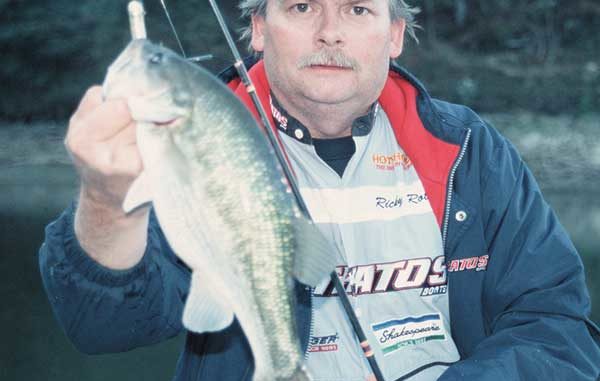
Largemouth, spotted, and smallmouth bass all biting at W. Kerr Scott
Good things often happen in threes at many sporting events.
Ice hockey has hat tricks celebrating the player who scores three goals in one game; basketball has its 3-pointer for long-range shots, and baseball designates the Triple Crown for the ballplayer who ranks first in his league in batting average, runs batted in, and home runs — all in the same season.
Good things also happen in threes in the sport of black bass fishing at W. Kerr Scott Reservoir.
A flood-control reservoir the mountains of Wilkes County, built by the U.S. Army Corps of Engineers in 1960 and completed in 1962, W. Kerr Scott has the distinction of being one of the few lakes in the state that holds populations of largemouth bass, smallmouth bass and spotted bass.
Renamed in 1963 in honor of a former governor and U.S. Senator from Haw River, the lake, originally called “Wilkesboro Dam and Reservoir Project,” covers 1,475 surface acres with 55 miles of shoreline in a locale once known as the “Moonshine Capital of the World,” which gained notoriety in the early days of NASCAR because of North Wilkesboro Speedway.
While racing remains a popular activity (even after the lamentable dropping of the speedway from the Sprint Car circuit), bass fishing has made inroads as more and more fishermen are discovering what W. Kerr Scott has to offer.
With a little luck, anglers can catch three species of black bass on a single trip to W. Kerr Scott, a feat that would be impossible in most state waters.
Of the three species, fishermen are most likely to catch spotted bass because they outnumber largemouth bass; smallmouth bass show up in smaller numbers.
During the reservoir’s early days, hooking three kinds of black bass wasn’t possible.
“We used to have only smallmouth and largemouth bass, but now spotted bass have taken over,” said Rick Roten of Millers Creek, who began tournament fishing when he was 11 years old as a member of the Yadkin Valley Bassmasters and who, along with touring pro Tracy Adams of North Wilkesboro, is co-owner of Hot Shot Lures.
Stocking records of the N.C.Wildlife Resources Commission, though incomplete, mirror the changes in the black bass populations at the lake over the years.
Smallmouth were stocked in 1962, the year the lake was impounded, and again in 1964, 1969 and 1971.
Stocking records for largemouth bass show some noticeable gaps.
“The only largemouth bass stockings I have records for were in 1969, although I’m certain they would also have been stocked when the reservoir was initially impounded in 1962,” said Kin Hodges, a fisheries biologist for the N.C. Wildlife Resources Commission whose territory encompasses northwestern North Carolina.
Spotted bass are a more recent addition. Although some spots found their way into W. Kerr Scott through angler introductions, the Commission stocked spotted bass between 1976 and 1979.
“At first, no one noticed any significant changes in the black bass populations,” Roten said, “but in recent years, the spots have really taken off, and a 5-fish catch of spots will average two to three pounds per fish. Fish weighing three or four pounds are fairly common.”
Roten and many local fishermen believe a spot big enough to topple the current state-record fish of 6 pounds, 5 ounces — taken from Lake Norman by Belmont’s Eric Weir — is swimming at W. Kerr Scott. In fact, a possible record spot weighing seven pounds was caught by Tommy Ireland of Hamptonville, who photographed the fish but didn’t get it weighed officially.
“It’s hard to weigh a picture,” Roten said.
The increase of spots and the apparent decline in the largemouth bass population has been met with disfavor by some W. Kerr Scott fishermen. Yet Commission sampling surveys are inconclusive with respect to the effect of spots on the largemouth bass population.
“Spotted bass are more abundant than largemouth bass,” Hodges said. “Some years, the numbers of each species we collect are fairly equal, while in other years, we get quite a few more spots than largemouth.
“I don’t think the actual ratio of spotted bass to largemouth bass really changes as much as our data suggests. A lot of that is due to variability in our sampling effectiveness.
“For instance, some years we time our sample right when all the largemouth are up shallow spawning, and we’ll collect high numbers of them. Other years, we might be just a little off with our timing and get there before or after many of them have already spawned, and our catches will be lower.
“Although it varies between years, based on data we have from 1989 to 2001, there isn’t a consistent trend of increasing spotted bass numbers and decreasing largemouth bass numbers.
“Whatever effect the initial introductions of spots might have had on the largemouth population, things appear to have reached equilibrium before our first sample in 1989, and they don’t appear to have changed a lot since then.”
Equipment problems have prevented biologists from sampling at W. Kerr Scott since 2001, though another survey has already been scheduled.
“But it’s safe to say that there are more spotted bass in the lake than largemouth bass,” Hodges said.
In contrast, smallmouth bass are considered “a bonus” if caught at all, though that situation may be changing as well.
“Smallmouth bass make up a negligible percentage of the black bass population,” Hodges said. “If I remember correctly, we’ve only come across one smallmouth in the electro-fishing and netting samples that I’ve been involved with. You do hear of some getting caught by anglers on occasion, but not on a regular basis.”
Roten, however, has seen an improvement recently in the smallmouth fishery.
“We’ve seen more smallmouth bass in the past four or five years than we’ve seen in the previous 10 years,” he said.
In past seasons when Roten fished at W. Kerr Scott, catching three species during a single outing was the last thing he had on his mind. Instead, he was concerned about which boat ramp would be available. An extended drought dropped the water level about 10 feet, which is as low as he’s seen.
Roten accesses the lake from the ramp at Smithey’s Creek Park off of US 421 at South Minton Road, the last ramp that will be exposed by low water. It is open 24 hours, with a $3 launch fee.
“Late September is the first good time for spots,” Roten said. “Cooler night-time temperatures during October further enhance the spot fishing.”
The usual mix of 30- to 40-degree nights and 60-degree days during a typical October creates a water temperature range from 60 to 70 degrees. The ideal water temperature for spots is 65 degrees.
The fish relate to the changes in water temperature and gradually migrate into the creeks where they can be caught with shallow-running crankbaits, conventional jigs, Shaky Head jigs, finesse worms (green pumpkin), big worms and tube lures. The strike zone is from three to eight feet.
An early-morning topwater bite is also possible along rocky banks. Roten said topwater action could last all day in cloudy weather.
A typical fall catch of five spots weighs from 13 to 15 pounds. Roten’s biggest spot has been a 4½-pounder.
An ideal situation for spotted bass, according to Roten, is when the lake is at full pool but being pulled, the water temperature ranging from 63 to 65 degrees, on an overcast day with a slight wind and light rain. That will put the majority of fish in three to four feet of water and susceptible to topwater baits, shallow-running crankbaits, and Shaky Head jigs.
Roten said spots at W. Kerr Lake appear more structure-oriented than they are at spacious Lake Norman. At W. Kerr Scott, spots hover around treelaps, rocks, humps, points, and stretches of shoreline where there’s a good dropoff. Unlike Norman, there’s a scarcity of piers, so they don’t serve as a major fish magnet.
During the fall, Roten fishes from Smithey’s Creek up. During the spring, he starts fishing at Smithey’s Creek and works his way in the other direction.
Other key areas include places with water flow, such as the backs of creeks and where the Yadkin River enters the lake.
Roten favors areas with moving water, but to his dismay, many of those places were dried up the past couple of years. However, the water has remained high this entire year, thanks to the strong spring rains.
But one area yielded the most spots on one trip last fall. He caught about five or six spots up to 2½ pounds on plastic tube baits and jigs cast into slowly moving water. Roten also caught a chunky largemouth from a treelap hugging the edge of a creek channel.
His fishing companion caught a smallmouth over two pounds that hit a tube bait cast towards another tree lap, and he also hooked several spots from the middle of the creek.
But neither angler could complete the “anglers’ hat trick.” Roten caught several spots and a largemouth, but no smallmouth bass, while his partner caught several spots and a smallmouth but no largemouth bass.
Roten landed another “bass” of sorts; he hooked a 2-pound hybrid bass at the back of another creek.
Diversity epitomizes W. Kerr Scott Reservoir. A fisherman never knows he might hook on his next cast. The lake not only harbors three kinds of black bass, but also blue catfish, channel catfish, rainbow trout, tiger muskellunge, walleye, white bass and hybrid bass.
Of the three species of black bass, spots and largemouth are most likely to mingle and to covet the same structure.
“When the fish are biting, you’re likely to pull up to a place and catch 15 to 17 pounds of largemouth, and then come back to the same place later and catch four or five spots,” Roten said. “Spots and largemouth gang up together.”
When the water temperature dips below 54 degrees, usually during the second week of December, the spots move back out and relate to deeper structure and cover, mostly in the form of rock and brush.
“Some local fishermen do very well in the dead of winter catching spots,” Roten said. “They vertical-jig river channels, creek mouths and deep brush piles in 17 to 20 feet of water with Hopkins (jigging spoons).”
Water clarity doesn’t often affect the spotted bass at W. Kerr Scott because the lake, fed by White’s Creek, Blood Creek, Warrior Creek and the Yadkin River, usually remains clear, though occasionally the backs of creeks have some color.
Clear water is a positive factor Roten said, because spots don’t bite as readily in muddy water.
Hodges supports this contention.
“Due to the relatively clear water in W. Kerr Scott, anglers don’t generally have as much luck beating the bank as they do in more turbid reservoirs,” he said.“The best catches seem to come from anglers who are more experienced in fishing deeper water.”
When Roten fishes for spotted bass, he selects All-Star rods and Pflueger reels spooled with 8- to 10-pound-test P-Line. For finesse baits and small crankbaits, he uses 6-foot medium-action rods. For largemouth bass, he switches to 6½- to 7-foot heavy-action rods and 17- to 20-pound line for deep summer cranking.
Once winter yields to warmer weather, the cycle begins again with prespawn bass. The prespawn period runs from the last week of February through March, when some hefty largemouth in the 7-pound class are caught on No. 7 and No. 8 Shad Raps and half-ounce spinnerbaits with double gold willow-leaf blades.
Most of the bass fishing takes place along the main channel, secondary points and rocky corners.
The spawn usually begins the second or third week in April, and by the time the dogwoods bloom in early May, it is in full force.
Despite the clear water, Roten said few spots will be taken by sight-fishing because they spawn much deeper than largemouth bass. Conversely, largemouth bass are taken by sight-fishing before they return to deep water.
From late May through June, big plastic worms and deep-diving crankbaits fished in 10 to 20 feet of water at main-channel points and deep brush piles take mostly largemouth bass.
“July and August are bad months for fishing here,” Roten said.“The heat, when coupled with little rain, is a bad combination.”
While Roten doesn’t maintain a guide service, he’s willing to help anglers unfamiliar with the lake — if he has a lull in his work schedule.
In 1958, the Kingston Trio turned Wilkes Count native Tom Dula into a local legend with the ballad, “Hang down your head, Tom Dooley.”
Fishermen at W. Kerr Scott Reservoir might become legends in their own minds if they catch all three species of black bass on a single trip. Perhaps some recording artist might even write a song about that achievement.

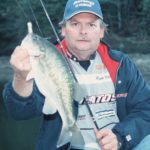
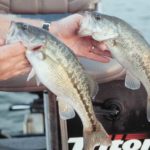
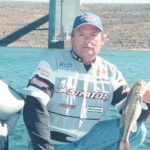
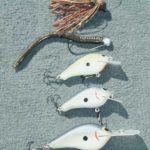
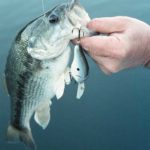
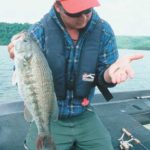



Be the first to comment